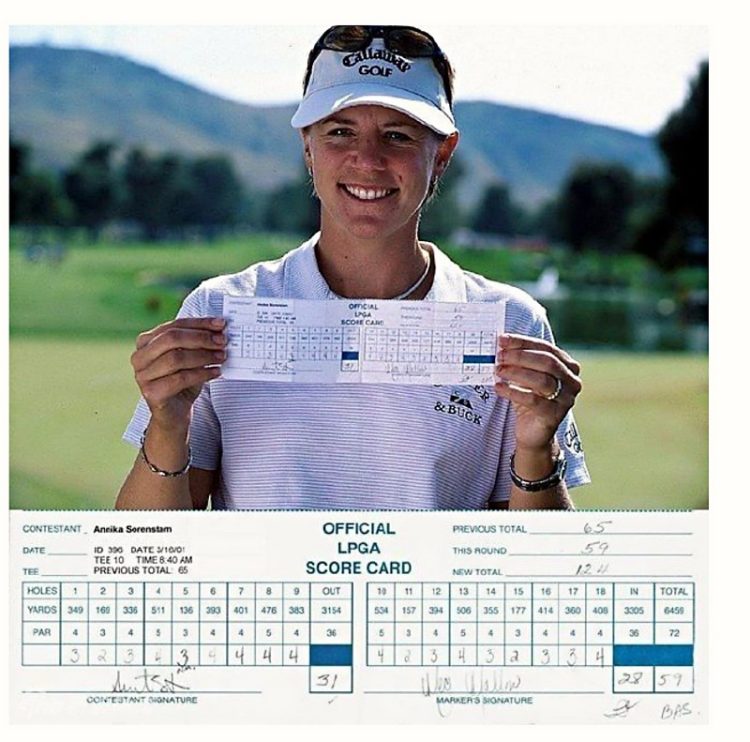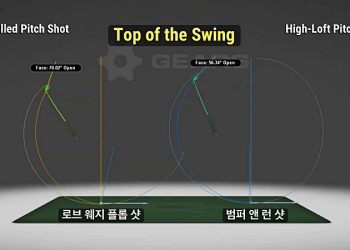2001년 LPGA 스탠더드 핑 레지스터 2라운드에서 애니카 소렌스탐은 13개의 버디를 잡으면서 꿈의 숫자인 59타를 쳤다. 이번엔 애니카의 레이저빔 같은 아이언샷을 소개한다.
애니카는 나와 진행한 방송에서 늘 아이언의 정확한 방향성 덕분에 우승을 많이 할 수 있었다고 했다. 드라이버 샷도 잘 맞았지만 아이언의 역할이 더 컸다는 것이다.
◇ 아이언샷의 기본
애니카는 6번 아이언을 칠 때는 마치 8번 아이언을 친다는 생각으로 샷을 한다. 마음에 부담을 상대적으로 덜 갖게 해 주기 때문이다.. 6번 아이언을 칠 때 또 하나 중요한 것은 허리를 곧고 단단하게 편 상태에서 편안한 셋업을 취하는 것이다. 그다음 볼의 위치는 중심 위치보다는 조금 왼쪽에 놓이도록 한다.
그리고 스윙의 템포에 많은 집중을 한다. 백스윙은 충분히 하고 피니시까지는 한 번에 가져간다. 59타를 쳤을 때도 위에 언급한 내용을 그대로 했다고 했다.
애니카는 6번 아이언으로 160야드를 치는데 늘 같은 거리를 만들어 내는 스윙에 집중한다. 그리고 항상 같은 템포로 샷을 하는 것이 중요한 포인트라고 강조했다. 레슨에 참여한 10세 주니어 선수(전영인 LPGA투어)를 위한 방향성과 임팩트 조언 역시 일정한 스윙 템포를 강조했다. 항상 일관된 몸의 회전과 다운스윙 시 같은 템포로 샷을 치는 것이 중요하다는 것이었다.
그리고 스윙할 때 팔이 늘 몸과 연결되어 있다는 느낌이 들어야 한다는 것도 조언했다. 몸의 균형이 약간 불안하다고 느끼면 스탠스의 폭을 살짝 넓히면서 안정감을 갖도록 했다. 연습 스윙과 샷을 할 때의 스윙이 다르게 나타날 수 있는데 이것 역시 편안한 마음으로 스윙의 템포에 집중하면 극복할 수 있다고 했다.
◇롱 아이언 다루기
4번 또는 5번 같은 롱아이언은 클럽 헤드의 로프트 각이 아주 낮기 때문에 볼을 띄워야 한다는 심리적 부담감 때문에 의도적으로 퍼 올리는 샷을 하기 쉽다. 또 거리를 멀리 보내야 한다는 생각 때문에 몸에 상대적으로 힘도 많이 들어간다. 스윙도 급해진다.
애니카는 이러한 문제점을 해결하기 위해서는 롱아이언을 칠 때는 마치 피칭웨지나 8번 아이언 스윙처럼 부드러운 느낌의 스윙을 가져가야 한다고 조언했다. 힘껏 볼을 때리려고 하지 말고 쉽고 편안한 느낌의 스윙을 하며, 긴 클럽이라도 몸이 아닌 클럽이 볼을 치게 해야 한다는 것이다.
4번이나 5번과 같은 롱아이언을 가지고 스윙을 하게 되면 그립부터 강하게 잡게 되고 볼도 낮게 날아가서 비거리도 줄게 된다. 클럽헤드 중앙에 볼을 맞히기도 쉽지 않다. 클럽 길이가 길어지게 되면 스윙을 하는데 시간도 상대적으로 더 오래 걸린다. 따라서 스윙을 빨리하려고 할수록 임팩트는 어렵게 된다. 이를 극복하는 방법이 8번 아이언이라고 생각하고 가볍게 스윙을 하는 것이다. 몸이 아닌 클럽이 스윙하도록 하는 것이다.
롱아이언을 잘 치기 위한 최고의 팁은 바로 이런 스윙의 템포이다. 이에 대해 애니카는 아이언을 잘 치기 위한 자신만의 비법을 다음 4가지로 정리했다.
첫째, 볼을 내리친다는 기분으로 스윙한다. 그래야 볼을 띄울 수 있다. 즉 어택 앵글의 중요성을 강조한다.
둘째, 백스윙할 때 어깨의 회전을 충분히 한다. 충분한 백스윙은 전체 스윙의 연결을 원활하게 해준다.
셋째, 다운스윙 시 하체로 리드를 하면서 스윙으로 가져간다. 이러한 동작은 임팩트의 로우 포인트를 길게 만들어 줌으로써 볼과 클럽헤드의 접촉시간을 늘리고 샷의 체공시간을 높일 수 있다.
넷째, 볼을 인위적으로 띄우려고 하지 말고 피니시까지 완전한 회전에 집중한다. 즉 다운스윙이 진행되면 생각을 하지 말고 오직 균형 있는 피니시 동작에 초점을 맞춰야 한다.
☞ 전욱휴는…
골프 칼럼니스트. PGA 클래스A 멤버이자 공인 티칭 및 코칭 강사다. 2001년부터 SBS, MBC, JTBC, YTN 등의 골프 채널에서 진행자 및 해설자로 활약했다. 현재 애틀랜타에서 골프 레슨 및 골프 관련 비즈니스를 하고 있다. chungolf@gmail.com
Golf Lesson by Dr.Eric Chun,PGA. 4. Annika’s Iron Full Swing
“Long Iron Shots: The More Comfortable, the Better. Don’t Swing with Your Body, Let the Club Do the Swing”
In the 2001 LPGA Standard Register Ping second round, Annika shot a dream score of 59 with 13 birdies. This segment on Annika’s iron shots focuses on the secrets behind her laser-beam-like iron shots. Annika mentioned in an interview with me that she was able to win many competitions mostly due to the accurate directionality of her irons, although her driver shots were good as well. The role of irons was more significant. Annika always thinks of hitting a 6 iron as if she is hitting an 8 iron. This mindset helps to reduce mental pressure. When hitting a 6 iron, another important aspect is to maintain a straight and firm posture while adopting a comfortable setup. After getting comfortable, the ball’s position is slightly to the left of the center. She also focuses greatly on the swing tempo, taking a full backswing and carrying through to the finish in one go. She followed these same principles when she shot the 59. Maintaining a consistent shot tempo is a key point she emphasizes. Annika focuses on producing the same distance with her 6 iron, concentrating on a consistent swing.
To a 10-year-old junior player (Youngin Chun,LPGA Tour) participating in the lesson, she similarly emphasized the importance of a consistent swing tempo for directionality and impact. She mentioned that maintaining consistent body rotation and the same tempo during the downswing is crucial. She also highlighted the importance of feeling that the arms are always connected to the body during the swing. If you feel slightly unstable in balance, she advised widening the stance a bit for more stability. Differences between practice swings and actual shots can be overcome by focusing on the swing tempo with a relaxed mindset.
Long irons create a psychological burden to launch the ball due to their low loft angles. Many weekend golfers, when hitting with a 4 or 5 iron, end up doing a scoop shot intentionally to get the ball airborne, and because they think they need to send the ball further, more force leads to hastiness in the swing. To solve these issues, she advised adopting a smooth swing feel similar to that of pitching wedges or 8 irons. In conclusion, when hitting a long iron, think of it as if you are swinging an 8 iron. Do not try to hit the ball forcefully but maintain an easy and comfortable swing. Even with a long club, let the club hit the ball, not your body. When she first started touring, she preferred woods over long irons because woods made it easier to get the ball airborne.
Swinging with long irons like the 4 or 5 causes one to grip the club too tightly, making the ball fly lower and reducing the distance. It is also not easy to hit the ball at the center of the club head. Annika admitted to having made many mistake shots in her attempts to lift the ball during her early years on tour. However, things improved a bit after gaining strength through weight training. Yet, more importantly, with long irons, one must focus on the tempo to fundamentally solve the distance and directionality issues. Longer club lengths mean the swing takes relatively more time, making a fast swing lead to a difficult impact. Even with a 4 iron, think of it as an 8 iron and swing lightly. Let the club, not the body, do the swinging. The best tip I have for hitting long irons well is always focusing on the swing tempo.
Annika summarized her personal secrets to good iron shots into four points:
First, swing as if you are striking down on the ball. This helps to launch the ball, highlighting the importance of the attack angle.
Second, ensure a full rotation of the shoulders during the backswing. This means making the left shoulder go past the ball’s position, which facilitates a smooth transition throughout the entire swing.
The third is to lead with the lower body during the downswing and take the swing through. This action elongates the low point of impact, extending the contact time between the ball and the club head, thereby increasing the hang time of the shot.
Lastly, the fourth is not to artificially try to lift the ball but to complete a full rotation up to the follow-through. In other words, as the downswing progresses, don’t think about it, but focus solely on achieving a balanced finish motion.


















![[전욱휴의 골프 레슨] 46. 배치기(얼리 익스텐션)](https://www.atlantajoongang.com/wp-content/uploads/2025/03/photoKakaoTalk_20250306_073237889_01-350x250.jpg?v=1741361116)
![[전욱휴의 골프 레슨] 45. 임성재 '행온페이드' 샷](https://www.atlantajoongang.com/wp-content/uploads/2025/02/collage1-350x250.jpg)
![[전욱휴의 골프레슨] 44. 일관된 샷을 원한다면](https://www.atlantajoongang.com/wp-content/uploads/2025/02/QKakaoTalk_20250212_065748485-350x250.jpg)

![[전욱휴 골프 레슨] 42. 오른쪽 팔꿈치 역할](https://www.atlantajoongang.com/wp-content/uploads/2025/01/qQ1KakaoTalk_20250130_072058648-350x250.jpg)
![[전욱휴의 골프 레슨] 41. 매킬로이 파워 스윙](https://www.atlantajoongang.com/wp-content/uploads/2025/01/qQ1KakaoTalk_20250122_123635940-350x250.jpg)





![트럼프 대통령과 멜라니아 여사 [로이터]](https://www.atlantajoongang.com/wp-content/uploads/2025/07/트펌프와-멜라니-2-350x250.jpg)
